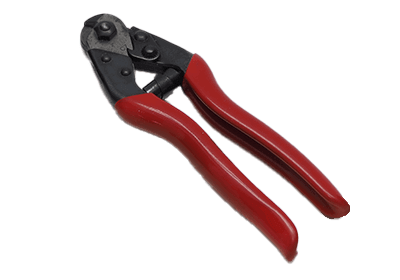What Is a Hand Wire Cutter?

A hand wire cutter is a tool for cutting linear materials such as wire rope, cable, and electric wire, which are bundles of thin wires.
Cutting with a hand wire cutter prevents the cut surface of the material from becoming frayed or falling apart. It produces a cleaner cross-section than when cutting with nippers, pliers, or other tools. Strong wires, such as stranded wires, which are made by weaving two or more metal wires together, can also be cut while maintaining their strength.
However, they are not suitable for cutting hard materials such as thick wire or piano wire, as the blades may chip or lose their sharpness.
How to Use Hand Wire Cutter
For the scissors type, similar to nippers or pliers, place the wire to be cut between the blades, grasp the handle by hand, and close the blades to cut.
In the case of the hydraulic manual type, the wire to be cut is set and secured in the blade, and then it is cut by the force of hydraulic pressure when the handle is raised or lowered.
In the case of the hydraulic electric type, there is no need to move the handle up and down. When the trigger of the hand wire cutter is pulled, hydraulic pressure is automatically applied, and the blade moves to cut the wire.
In the case of the electric type, the wire to be cut is clamped between the blades and the hand wire cutter is turned on. Then, pull the trigger of the main unit and the blades move automatically to cut the wire.
How to Select a Hand Wire Cutter
When selecting hand wire cutters, be sure to check the maximum cutting capacity, which indicates the maximum diameter of wire that can be cut at one time, and the materials that can be cut. Cutting capacity is generally indicated as “20 mm diameter” or “Φ20 mm”. Some are also described together with the material that can be cut, such as “IV Φ20 mm.” In this case, it indicates that IV wires (vinyl-insulated wires) up to 20 mm in diameter can be cut.
There are four main types of hand wire cutters: pliers, ratchet, hydraulic, and electric. The type is selected according to the thickness and hardness of the wire to be cut. The features of each type are summarized below.
- Plier Type
Similar in shape to pliers or nippers, these cutters are easy for beginners to handle and can cut wires of hardness and thickness that cannot be cut with nippers. Because they are light and easy to carry, they are also suitable for precision work. - Ratchet Type
By moving the blade only in the cutting direction through the “ratchet mechanism,” which transmits rotation only in one direction and not in the opposite direction, even thicker wires can be cut with less force. - Hydraulic Type
By transmitting power to the blade through pressurized oil, wires can be cut more quickly with less force. Therefore, it can be used in high places or in places with poor footholds. It also reduces the burden of long hours of work and frequent cutting work. - Motor-Driven
By operating the blade with a motor, the wire can be easily cut at high speed without applying force. Its extremely high cutting capacity makes it suitable for replacing elevator wire ropes and cutting wires in areas where sparks are prohibited. There are two types of electric models: the outlet type, which is used by connecting it to an electrical outlet, and the rechargeable type. In the case of the outlet type, the working range is limited by the location of the power source and the length of the cord. In contrast, with rechargeable types, you need to consider that the working time is limited.
Hand wire cutters come in a variety of blade shapes and safety features as well as types, so choose appropriately according to your application and purpose. The following is a summary of the main safety features and blade shapes.
- Shape of Blade
Double-edged blades have more cutting force than single-edged blades, so less force is required to cut. However, it is not suitable for cutting thicker wires. The single-edged blade requires more force than the double-edged blade, but it can fix and cut thicker wires that are difficult to cut with the double-edged blade. - Safety Performance
It is safe if the hand wire cutter has an open/close lock or stopper feature to prevent the blade from opening or moving when the cutter is not in use or when work is interrupted. Also, when cutting cables and wires, it is safer to choose a wire cutter with an insulated handle to prevent electric shock in the event that the wire cutter is energized.